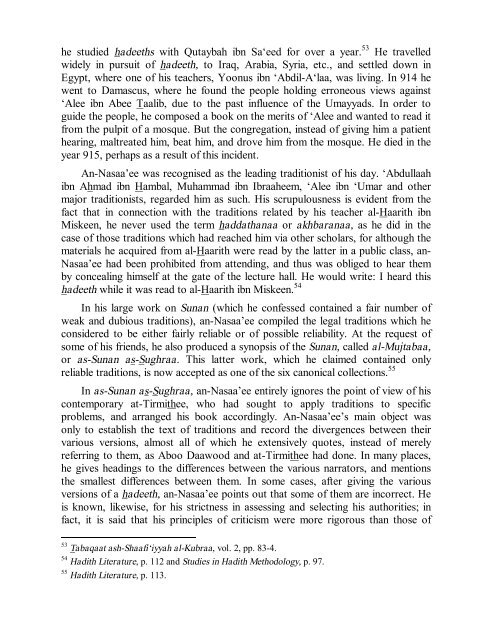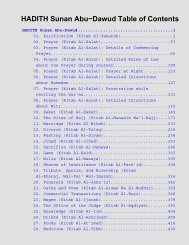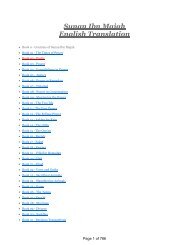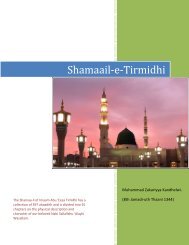he studied hadeeths with Qutaybah ibn Sa‘eed for over a year. 53 He travelledwidely in pursuit of hadeeth, to Iraq, Arabia, Syria, etc., and settled down inEgypt, where one of his teachers, Yoonus ibn ‘Abdil-A‘laa, was living. In 914 hewent to Damascus, where he found the people holding erroneous views against‘Alee ibn Abee Ta<strong>al</strong>ib, due to the past influence of the Umayyads. In order toguide the people, he composed a book on the merits of ‘Alee and wanted to read itfrom the pulpit of a mosque. But the congregation, instead of giving him a patienthearing, m<strong>al</strong>treated him, beat him, and drove him from the mosque. He died in theyear 915, perhaps as a result of this incident.An-Nasaa’ee was recognised as the leading traditionist of his day. ‘Abdullaahibn Ahmad ibn Hamb<strong>al</strong>, Muhammad ibn Ibraaheem, ‘Alee ibn ‘Umar and othermajor traditionists, regarded him as such. His scrupulousness is evident from thefact that in connection with the traditions related by his teacher <strong>al</strong>-Haarith ibnMiskeen, he never used the term haddathanaa or akhbaranaa, as he did in thecase of those traditions which had reached him via other scholars, for <strong>al</strong>though themateri<strong>al</strong>s he acquired from <strong>al</strong>-Haarith were read by the latter in a public class, an-Nasaa’ee had been prohibited from attending, and thus was obliged to hear themby conce<strong>al</strong>ing himself at the gate of the lecture h<strong>al</strong>l. He would write: I heard thishadeeth while it was read to <strong>al</strong>-Haarith ibn Miskeen. 54In his large work on Sunan (which he confessed contained a fair number ofweak and dubious traditions), an-Nasaa’ee compiled the leg<strong>al</strong> traditions which heconsidered to be either fairly reliable or of possible reliability. At the request ofsome of his friends, he <strong>al</strong>so produced a synopsis of the Sunan, c<strong>al</strong>led <strong>al</strong>-Mujtabaa,or as-Sunan as-Sughraa. This latter work, which he claimed contained onlyreliable traditions, is now accepted as one of the six canonic<strong>al</strong> collections. 55In as-Sunan as-Sughraa, an-Nasaa’ee entirely ignores the point of view of hiscontemporary at-Tirmithee, who had sought to apply traditions to specificproblems, and arranged his book accordingly. An-Nasaa’ee’s main object wasonly to establish the text of traditions and record the divergences between theirvarious versions, <strong>al</strong>most <strong>al</strong>l of which he extensively quotes, instead of merelyreferring to them, as Aboo Daawood and at-Tirmithee had done. In many places,he gives headings to the differences between the various narrators, and mentionsthe sm<strong>al</strong>lest differences between them. In some cases, after giving the variousversions of a hadeeth, an-Nasaa’ee points out that some of them are incorrect. Heis known, likewise, for his strictness in assessing and selecting his authorities; infact, it is said that his principles of criticism were more rigorous than those of53 Tabaqaat ash-Shaafi‘iyyah <strong>al</strong>-Kubraa, vol. 2, pp. 83-4.54 <strong>Hadith</strong> Literature, p. 112 and Studies in <strong>Hadith</strong> Methodology, p. 97.55 <strong>Hadith</strong> Literature, p. 113.
Muslim. 56 The book does, however, contain many weak and doubtful traditionsrelated by unknown narrators of questionable credenti<strong>al</strong>s.An-Nasaa’ee’s Sunan did not attract the attention of early scholars withregard to commentary. As-Suyootee wrote a short commentary c<strong>al</strong>led Zahrur-Rabaa ‘<strong>al</strong>aa <strong>al</strong>-Mujtabaa, more than 500 years later. 57The Sunan of Ad-DaarimeeThis is among the earliest sunan works to have come down to us. Its author, AbooMuhammad ‘Abdullaah ibn ‘Abdir-Rahmaan (797-868) was a member of theArabian clan of the Banoo Daarim, an offshoot of the tribe of Tameem. Likemany of his contemporaries, he travelled a good de<strong>al</strong> in search of hadeeths, andstudied under important traditionists such as Yazeed ibn Haaroon and Sa‘eed ibn‘Aamir. Well-known for his devotion to his field, he was <strong>al</strong>so celebrated for hishonesty and piety. When offered a post as judge at Samarqand he refused, afraidhe might commit an injustice, until he was pressed hard to accept; and he resignedafter judging only one case. 58The Sunan of ad-Daarimee contains some 3,550 traditions, arranged in 1,408chapters according to subject matter. One speci<strong>al</strong> feature of the book is its gener<strong>al</strong>introductory chapter in which the compiler presents a number of hadeethsconnected with a range of matters, including certain usages of the Arabs beforeIslaam, traditions connected with the life and character of the Prophet (r),materi<strong>al</strong> related to the written recording of hadeeths, and the great importance ofknowledge. In the main body of the text, ad-Daarimee follows the same plan asthe later sunan compilers. After citing a group of traditions, he adds notes, insome of which he offers his own opinion on certain problems, identifies somenarrators, or criticises their reliability, or draws attention to variant versions of atradition. These notes, however, are much briefer than those appended to thepreviously mentioned sunan works.The book is gener<strong>al</strong>ly accepted as an important source, and has been regardedby some traditionists as the sixth of the canonic<strong>al</strong> collections. It never, however,attained the position of the any of the former three works, because it containsmore weak and defective traditions than they do. 5956 Tathkirah <strong>al</strong>-Huffaaz, vol. 2, p. 268.57 Studies in <strong>Hadith</strong> Literature, p. 98.58 Tathkirah <strong>al</strong>-Huffaaz, vol. 2, pp. 115-7.59 <strong>Hadith</strong> Literature, pp. 113-5.
- Page 2:
[Usool Al Hadeeth]The Methodology o
- Page 6 and 7:
from the Prophet of his actions, sa
- Page 8 and 9:
3. LawsOne of the primary duties of
- Page 10 and 11:
authentically attributable to the P
- Page 12 and 13:
was asked which city will be conque
- Page 14 and 15:
Rahmaan, who was at that time the m
- Page 16 and 17:
centuries. They also grouped the ha
- Page 18 and 19:
Prophet's lifetime, and in the wars
- Page 20 and 21:
JAABIR IBN ‘ABDILLAAH. One of the
- Page 22 and 23:
2. ‘Ard : Reading by the Students
- Page 24 and 25:
Transmission TerminologyThe hadeeth
- Page 26 and 27:
EVOLUTION OF THE SANADTeaching the
- Page 28 and 29:
the Sahaabah had left off and began
- Page 30 and 31:
In this case the Sanad is shorter b
- Page 32 and 33:
The Pattern of IsnaadThe usual patt
- Page 35 and 36:
Origins of the Isnaad SystemEvery t
- Page 37 and 38:
FOUR: ClassificationDue to a variet
- Page 39 and 40:
Hadeeth SaheehA hadeeth must meet t
- Page 41 and 42:
Saheeh li GhayrihThe hadeeth saheeh
- Page 43 and 44:
ecorded by others.5. Authentic hade
- Page 45 and 46:
Abee Awfaa wrote to him saying that
- Page 47 and 48:
Muhammad ibn Bashshaar informed us
- Page 49 and 50:
Ruling on Da‘eef NarrationsSchola
- Page 51 and 52:
In this narration, he deleted the c
- Page 53 and 54:
called Taghleeq at-Ta‘leeq (Closi
- Page 55 and 56:
The jurists (fuqahaa) generally def
- Page 57 and 58:
Caesar’s emissary collected by Ah
- Page 59 and 60:
Muwatta 42 with the following chain
- Page 61 and 62:
Saqiyah called him Aboo Wahb al-Asa
- Page 63 and 64:
Khateeb al-Baghdaadee’s book call
- Page 65 and 66:
The Mu’annan is a hadeeth in whic
- Page 67 and 68:
and the household of the Prophet (r
- Page 69 and 70:
The supporters of each opinion fabr
- Page 71 and 72:
(Soorah al-Israa, 17: 79) he said t
- Page 73 and 74:
7. Inventions for Personal Motives:
- Page 75 and 76:
Zamakhasharee and ash-Shawkaanee.Li
- Page 77 and 78:
definitions by other scholars are:1
- Page 79 and 80: FIVE: ConflictIn vast number of nar
- Page 81 and 82: farewell Hajj as well as on other o
- Page 83 and 84: caught) but on the fourth occasion
- Page 85 and 86: hadeeth narrations. So much so that
- Page 87 and 88: Mulaykah, 14 az-Zuhree 15 and Shu
- Page 89 and 90: them in ash-Sha‘bee’s direction
- Page 91 and 92: ased on the relative reliability of
- Page 93 and 94: Step Four: The eras of the narrator
- Page 95 and 96: ) متواتِر بِال ْمعن
- Page 97 and 98: have even claimed Ijmaa‘ (unanimi
- Page 99 and 100: What further explains this Qur’aa
- Page 101 and 102: Bukhaaree - the most correct book a
- Page 103 and 104: 3. ‘Abdullaah ibn ‘Umar said:
- Page 105 and 106: of scholars. It is false because it
- Page 107 and 108: This hadeeth was narrated from Anas
- Page 109 and 110: the view that discrepancies between
- Page 111 and 112: EIGHT: LiteratureThe origins of the
- Page 113 and 114: collected hadeeths which were relat
- Page 115 and 116: Ibn Hambal began lecturing on tradi
- Page 117 and 118: students, and also to his sons and
- Page 119 and 120: The final chapter is on Shamaa’il
- Page 121 and 122: On many occasions al-Bukhaaree’s
- Page 123 and 124: Saheeh of Muslim ibn al-Hajjaaj ibn
- Page 125 and 126: have examined 500,000 hadeeths, and
- Page 127 and 128: Islamic world. 43 Sunan Abee Daawoo
- Page 129: them on account of its isnaad. I he
- Page 133 and 134: Ad-Daaraqutnee rapidly acquired a s
- Page 135 and 136: men had to be appointed to repeat h
- Page 137 and 138: The Zawaa’id Work of al-Haythamee
- Page 139 and 140: (iv) They had been used as a basis
- Page 141 and 142: the well-known Kitaab al-Ansaab of
- Page 143 and 144: notices of more than 40,000 narrato
- Page 145 and 146: Zaynud-Deen al-‘Iraaqee (725-806/
- Page 147 and 148: forced to leave the city and wander
- Page 149 and 150: the author. But the work could not
- Page 151 and 152: TEN: Women Scholars of HadeethHisto
- Page 153 and 154: daughter of the distinguished juris
- Page 155 and 156: turn lectured to many students, som
- Page 157 and 158: excelled in the art of calligraphy
- Page 159 and 160: occurs only in Mutayyin’s narrati
- Page 161 and 162: Abu Bakr as-Siddeeq, then to Ali ib
- Page 163 and 164: ف َأ َمسك َها ف َل
- Page 165 and 166: Haakim, Muhammad ibn ‘Abdillaah a
- Page 167: Thahabee, Muhammad ibn Ahmad ath-.





